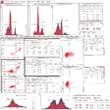|
22nd Workshop of the AIDPIT Study Group. Innsbruck, Austria (January 26-28, 2003)
THE INFLUENCE OF NICOTINAMIDE ON APOPTOSIS OF ISLET CELLS AFTER INTRAVASCULAR TRANSPLANTION IN DOGS
V.A. Goranov
Objectives. During the past decades three major approaches to macroencapsulation have been studied by different investigators. These include intravascular macrocapsules, which are anastomosed to the vascular system as AV shunt; extravascular macrocapsules, which are mostly diffusion chambers transplanted at different sites; and extravascular microcapsules transplanted in the peritoneal cavity. The advantages and pitfalls of these three approaches are discussed and compared in the light of their applicability to clinical islet transplantation. All systems have been shown to be successful in preclinical studies. But usually microcapsules, due to their spatial characteristics, have a better diffusion capacity than macrocapsules. Recent progress in biocompatibility of microcapsules has brought this technology close to clinical application. Critical issues such as limitations in the functional performance and survival are being discussed. The latest results show that both issues can be solved by the transplantation of islets close to blood vessels.
The development of intravascular transplantation methods requires to investigate apoptosis processes that can accompany this manipulation. Nicotinamide is an effective PARP inhibitor and can protect β-cells from some lethal forms of injury. The aim of our experiments was to investigate the influence of preliminary treatment of islet cells with nicotinamide on the development of apoptosis in islet cells after intravascular transplantation.
Materials and Methods. Isolated rat pancreatic islets were precultured for 10 days with nicotinamide (10 mM) or remained untreated. Then islets were closed in polyamide macrocapsules with pore size up to 1 μm and transplanted intravasculary in dogs with streptozotocin diabetes. Part of the capsules was transplanted in dogs without diabetes (control). Every 3rd day (by 12th day) after transplantation the capsules were removed from dogs. The islets were carefully removed from the capsules and prepared with EDTA and collagenase into single cell suspension. Caspase-3/Propidium Iodide Assay Kit (Intergen) was used for detection of apoptosis in cells by FACS-analysis.
Results. The maximal amount of apoptotic (caspase-3 positive) cells was registered in the experimental group without nicotinamide treatment on the 3 day after transplantation (36.4±4.8%). On the 6th day in the same group maximal amount of dead cells (propidium-positive) was observed (49.5±11%). In the Nicotinamide-treated group the maximum of Caspase-3 activity was registered on the 6th day (15.0±2.3%) and no more than 24.4±1.3% (9th day) of propidium-positive cells were registered during observation period. In the control groups of animals maximal destruction was observed on the 3rd day after transplantation as in islet cells treated with nicotinamide (8.4±1.5%), such in untreated cells (13.8±0.9%). But activity of caspase-3 was registered only on the level 3.6±1.2% in experimental group untreated with nicotinamide.
Conclusion. It is possible to conclude that preliminary treatment of islet cells by nicotinamide decreases its susceptibility to apoptosis that induced by immunoagressive factors of the blood of dogs with streptozotocin diabetes. On the other hand - can't be excluded that stress, obtained by the cells during transplantation procedures, can decrease its resistance to apoptogenic stimuli.
|



